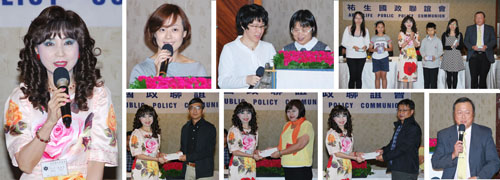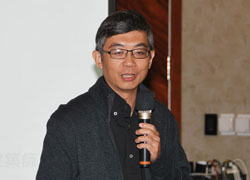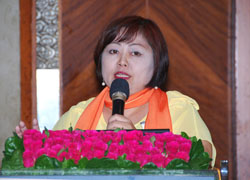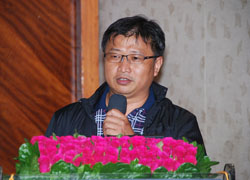
本會已於2016年11月27日假台北喜來登大飯店地下二樓壽廳舉行「祐生國政聯誼會」。在主持人黃晉英秘書長宣布後揭開當日活動序幕,在輕鬆、活潑的節目過後,隨即由主持人帶來重要訊息:「面對氣候異變的威脅,祐生持續進行相關研究,擷取東西方之長,建構能通過未來之數位共生新文明。另外,社會亂象頻傳,利用社群軟體進行詐騙的手法亦層出不窮,對應的方式即為林俊興董事長一再提示:「保守、保守、再保守」,行事思慮周全才能保全自身。過去十五年,祐生為創新文明做了許多努力,目前第三任潛鋒特組也從各個面向持續探討未來百年人類生活情境變化之預測。未來,請各位與祐生持續努力,共同推動新文明!」
The November Archilife Public Policy Communion of 2016 was held on November 27, 2016. After a series of relaxing and fun activities, Secretary General Huang Chin-ying made the following announcement, "We have heard of numerous incidents that reflect chaotic order in society, such as fraud spreading in social media. President Lin Chun-shin reminded us that the way to deal with such chaos is being "conservative, careful, cautious". The way to keep yourself safe is to think things through. In the past 15 years, Archilife has made tremendous efforts to push forward the development of creative civilization. At present, the third Pioneer Team is exploring the possible changes in lifestyle that mankind is likely to go through in the next century. In the future, please continue to work with Archilife. Together, we will bring a new civilization."

緊接著進行專題演講,由國政會委員李宏堅先生主講「永續環境之實踐:以都市更新為例」。主講人首先提到建築物的生命週期以及藉由都市更新重建實踐節能減碳的概念。主講人提出個案佐以圖片分享,實踐方案重視整體性規劃,留設寬敞的人行步道,四周種植植栽綠化。建築本體外觀簡潔,達成施工過程減碳的效果;採用深凹窗以減少日照,降低空調負荷。在過程中,「拆除」為重要的里程碑,雖然房屋老舊,但對每個屋主而言有深厚的感情,故實施者將過程予以記錄,留予屋主紀念。最後,主講人表示每個都更案的成功是開發商與地主的相互成就,在彼此感恩的氛圍中,推動都市更新。
Next on the schedule was the keynote speech. First, Mr. Li Hung-chien, presented a speech on the "Practice for a Sustainable Environment:City Renewal". The speaker began from the lifecycle of buildings and the concept of energy-saving and carbon reduction through city renewal. He shared four cases through rich illustrations and photographs. He elaborated that all four cases were planned in a holistic concept, including wide pedestrian walks and green landscapes. Exteriors of the structures are simple without excessive designs to achieve carbon reduction in the process of construction and recessed windows cut down direct sunlight to reduce the load on air conditioning. "Demolition" was a significant milestone in the process. Although the buildings are old, each of the house owners had a certain level of attachment to the places. Therefore, the project enforcer documented the process for the house owners as a memorabilia. In conclusion, the speaker pointed out that every successful city renewal case was achieved by compromises between the developer and estate owners. They pushed forward the projects with gratitude to each other.

接著由國政會委員孫瑞穗小姐主講「活水旋城‧創新城市:談談創意城市運動」。主講人首先提到創意城市的源起,是以文化經濟、科技和創意人才聚集的空間模型。主講人接著針對以「創意城市」為題的論述作介紹,並舉出建構「創意城市」的取徑之個案:再聚集策略有大規模聚集:好萊塢、寶萊塢及小聚集:紐約東村、倫敦科芬花園;城市轉型策略有劍橋、南韓;城市再生策略有奧地利薩爾斯堡;培育策略有矽谷科技園區、波斯頓科學園區。最後,主講人表示創意城市為人類未來居住空間很重要的發展,期望未來能透過全民參與創意城市的形式,讓居住空間、生活品質更美好。
Next, Miss Sun Ruei-suei, spoke on "Living Water Turns on a City: The Creative City Movement". The speaker began from the origin of a creative city and provided a definition: A creative city is a spatial model that converges cultural-economic, technological and creative talents. She continued to elaborate on the theories and introduced cases of "creative city", including large cities of the "agglomeration strategy", such as Hollywood and Bollywood, and small cities, such as the East Village of New York and Covent Garden of London, "city transformation strategies", such as Cambridge and South Korea, "city renewal strategies", such as Salzburg of Austria, and "incubation strategies", such as Silicon Valley and Boston Science Park. Finally, the speaker stressed that creative city is a significant development in the future of human dwelling and she hoped that we can bring better living spaces and quality of living through public participation in the forming of creative cities.

接著由國政會委員陳遠鴻先生主講「無障礙設施設置探討」。主講人首先提到無障礙設施的設置,不僅為殘障者,也包括老弱婦孺等族群。在室外通路部分,通路不同時須設引導標誌,並避免地面不平整及不當鋪設導盲磚導致妨礙輪椅行進。在避難層坡道部分,應設置符合規定之連續性扶手及防勾撞處理,並避免坡度過大使用困難。主講人提出常見到的缺失為室內出入口高低差未設置坡道;通路走廊擺設障礙物;樓梯缺乏防護及警示標示;廁所盥洗室之扶手、沖水鈕及緊急按鈕位置設置不當。主講人以豐富圖片舉出許多實例,讓與會者認知到無障礙設施的專業性及安全正確設置的重要性。
Next, Mr. Chen Yuan-hung, spoke on "Easy Access Facilities". The speaker began from stating that easy access facilities are not only for users with disabilities, but also for the elderly, the incapacitated and women with children. He added that guiding signs should be installed along outdoor passages and obstructed ground, including obstruction by poorly designed tactile paving, should be avoided to facilitate free movement of wheelchair. Ramps at refuge floors should have continuous railings and obstruction-collision prevention designs that meet the standards of regulatory requirements, and over-steep slopes should be avoided. The speaker pointed out common fallacies in easy access designs, including no ramps for the gap between indoor and outdoor grounds, objects placed in passageways, no fall-protection or warning signs before stairways and poorly-located railings, flush buttons and emergency buttons in washrooms. The speaker presented informative and professional knowledge on easy access facilities with rich photos and case studies and stressed the significance of accurate and safe installation.
演講完畢,黃晉英秘書長代表基金會致贈謝禮予主講人。接著在與會者紛紛利用「餵豬時間」提出個人意見與看法互相交流後,圓滿地結束十一月份國政聯誼會。
After the speech, Secretary General Huang Chin-ying presented a gift to the speakers on behalf of the foundation. Then, attendees expressed and exchanged their opinions and views during the piggy hour. The November Archilife Public Policy Communion ended smoothly.